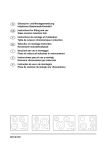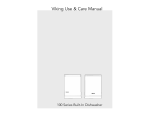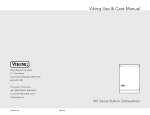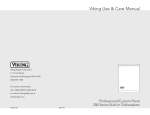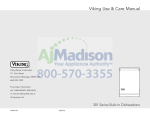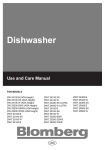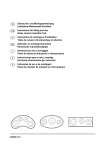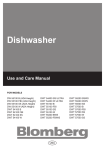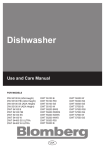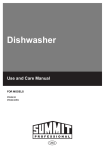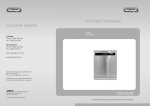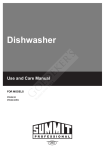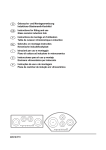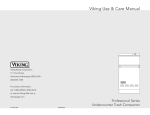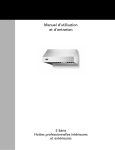Download Use & Care Manual
Transcript
Use & Care Manual Viking Range, LLC 111 Front Street Greenwood, Mississippi 38930 USA (662) 455-1200 For product information, call 1-888-845-4641 or visit our web site in the US at www.vikingrange.com or in Canada at www.brigade.ca 3 Series Built-In Dishwasher F21314 (101513) Congratulations Table of Contents Your dishwasher is designed to offer years of reliable service. This Use & Care Guide will provide you with the information you need to become familiar with your dishwasher’s operation and care. Getting Started Your complete satisfaction is our ultimate goal. If you have any questions or comments about this product, please contact the dealer from whom you purchased it, or contact our Consumer Support Center at 1-888-845-4641. For more information about the complete and growing selection of products, contact your dealer or visit us online in the US at www.vikingrange.com or in Canada at www.brigade.ca Warnings & Safety ____________________________________________4 Important Safety Instructions ___________________________________5 Installation ___________________________________________________8 Features ____________________________________________________10 Operation Loading the Dishwasher ______________________________________11 Rack Adjustments ___________________________________________13 Proper and Improper Loading_________________________________17 Operating Instructions _______________________________________20 Program Table ______________________________________________21 Function Buttons ____________________________________________22 Detergent and Rinse Agent Dispenser _________________________27 Product Care Care and Maintenance _______________________________________34 Cleaning the Filters __________________________________________36 Cleaning the Spray Arms _____________________________________38 Troubleshooting _____________________________________________39 Service Information __________________________________________45 Warranty ___________________________________________________46 2 3 Getting Started Please read this user manual and particularly the safety instructions completely and carefully. They will save you time and effort and help to ensure optimum dishwasher performance. Be sure to observe all listed warnings and cautions. Look particularly for the icons with exclamation marks inside. The information icon will also provide important references. Warning and Important Safety Instructions appearing in this manual are not meant to cover all possible conditions and situations that may occur. Common sense, caution, and care must be exercised when installing, maintaining, or operating the appliance. ALWAYS contact the manufacturer about problems or conditions you do not understand. Important Safety Instructions WARNING When using the dishwasher, follow basic precautions, including the following: Read all instructions before using the dishwasher! Save these operating instructions and pass them on to any future user. • Use the dishwasher only for its intended purpose as described in this user manual. This appliance is intended for normal household use only. • The manufacturer disclaims responsibility for damage or injury caused by improper use of this appliance. Recognize Safety Symbols, Words, Labels WARNING Indicates a potentially hazardous situation which, if not avoided, could result in death or serious injury. CAUTION Indicates a potentially hazardous situation which, if not avoided, may result in injury. It may also be used to alert against unsafe practices. NOTICE Indicates a potentially hazardous situation which, if not avoided, may result in damage to the dishwasher, the tableware, the equipment, or the environment. Read and follow all instructions before using this appliance to prevent the potential risk of fire, electric shock, personal injury or damage to the appliance as a result of improper usage of the appliance. Use appliance only for its intended purpose as described in this manual. To ensure proper and safe operation: Appliance must be properly installed and grounded by a qualified technician. DO NOT attempt to adjust, repair, service, or replace any part of your appliance unless it is specifically recommended in this manual. All other servicing should be referred to a qualified servicer. 4 • The information in this user manual must be followed to minimize the risk of fire or explosion and to prevent property damage, personal injury, or loss of life. • DO NOT operate your dishwasher unless all the enclosure panels are properly in place. • DO NOT tamper with the controls. • DO NOT abuse, sit on, stand in or on the door or dish rack of the dishwasher. • The cup racks are designed to support cups, glasses, and kitchen utensils. When the cup racks are in the dishwasher, do not lean on or use the cup racks to support your body weight. • To reduce the risk of injury, DO NOT allow children to play in, on, or near the dishwasher. • Use only detergents or rinse agents recommended for use in a household dishwasher and keep them in a dry place out of the reach of children. Check that the detergent dispenser is empty after the completion of each wash program. 5 Getting Started Warnings & Safety Getting Started Important Safety Instructions • Dishwasher detergents are alkaline. They can be dangerous if inhaled or swallowed. Avoid contact with skin and eyes and keep children and people in poor health away from the dishwasher when the door is opened. Consult a doctor immediately if detergent has been swallowed or inhaled. • This appliance must be grounded. In the event of a malfunction or breakdown, grounding will reduce the risk of electric shock by providing a path of least resistance for electric current. This appliance is equipped with a cord having an equipment-grounding conductor and a grounding plug. The plug must be plugged into an appropriate outlet that is installed and grounded in accordance with all local codes and ordinances. • DO NOT drink water from the dishwasher! Harmful residues could be present. • Under certain conditions, hydrogen gas may be produced in a hot water heater system that has not been used for two weeks or more. HYDROGEN GAS IS EXPLOSIVE. If the hot water system has not been used for such a period, before using the dishwasher turn on all hot water taps and let the water flow from each for several minutes. This will release any accumulated hydrogen gas. As gas is flammable, do not smoke or use an open flame during this time. • DO NOT store or use flammable liquids or vapors in the area of the dishwasher. • When loading items to be washed, position sharp items so that they are not likely to damage the door seal and load sharp knives with the handles up to reduce the risk of cut-type injuries. • DO NOT wash plastic items unless they are marked “dishwasher safe” or the equivalent. For plastic items not so marked, check the manufacturer’s recommendations. • If a malfunction occurs, switch off the appliance and turn off the water supply to the dishwasher. • Before cleaning or carrying out maintenance, switch off the appliance, disconnect the power plug, and turn off the water supply. • This appliance must be connected to a grounded metal, permament wiring system, or an equipment-grounding conductor must be run with the circuit conductors and connected to the equipment-grounding terminal or lead on the appliance. WARNING Improper connection of the equipment-grounding conductor can result in a risk of electric shock. Check with a qualified electrician or service representative if you are in doubt whether the appliance is properly grounded. Do not modify the plug provided with the appliance; if it will not fit the outlet, have a proper outlet installed by a qualified electrician. WARNING State of California Proposition 65 -This product contains one or more chemicals known to the State of California to cause cancer. -This product contains one or more chemicals known to the State of California to cause birth defects or other reproductive harm. SAVE THESE INSTRUCTIONS! • Repairs and technical modifications must be carried out exclusively by a qualified technician. • If the dishwasher is not in use for an extended period of time (i.e. vacation home), we recommend you check that the baskets are empty, leave the inside of the dishwasher clean, leave the door cracked open to allow air to circulate, and turn off both the power and water supply to the dishwasher. 6 7 Getting Started Important Safety Instructions Getting Started Installation WARNING When using the dishwasher, follow basic precautions, including the following: • The dishwasher installation must be performed in accordance with the installation guide. If you did not receive an installation guide, order it by calling 1-888-1-888-845-4641or you may also download it from our website in the US (www.vikingrange.com) or in Canada (www.brigade.ca). • Installation, maintenance, and repair should be performed by a qualified installer. Work by unqualified persons could be dangerous and may void the warranty. WARNING DANGER OF SUFFOCATION! Ensure that any plastic wrappings, bags, small pieces, etc., are disposed of safely and kept out of the reach of children. • Remove the dishwasher door when removing an old dishwasher from service or discarding it. Ensure that the dishwasher presents no danger to children while being stored for disposal. • Old appliances may contain materials that can be recycled. Please contact your local recycling authority about the possibility of recycling these materials. • DO NOT operate the dishwasher if damaged, malfunctioning, partially disassembled, or if it has missing or broken parts. • Before installation or service, disconnect the power supply to the work area by unplugging the unit, “tripping” the circuit breaker, or removing the fuse. • Only connect the dishwasher to the power supply when all installation and plumbing work is complete. • DO NOT install or store the dishwasher where it can be exposed to below freezing temperatures or exposed to weather. • Dishwasher must be secured to adjacent cabinetry using the brackets provided. Failure to do this may cause damage to property or bodily injury. • Connect to a properly rated, protected and sized power supply circuit to avoid electrical overload. The dishwasher is designed for an electrical supply of 120V (volts), 60Hz (hertz), AC, connected to a dishwasher-dedicated, properly grounded electrical circuit with a fuse or breakers rated for 15 amperes. Electrical supply conductors shall be a minimum of #16 AWG copper wire rated at 167°F (75°C) or higher. These requirements must be met to prevent injury and machine damage. Consult a qualified electrician if in doubt. • DO NOT use any extension cord or portable outlet device to connect the dishwasher to a power supply. 8 9 Getting Started Installation Getting Started Loading the Dishwasher • Pull the handle to open the door. If the door is opened during operation, the dishwasher will stop running. Once the door is closed, the program will continue. Upper Rack Lower Rack Top rack load pattern for 14 place settings according to the AHAM DW-1 Standards Bottom rack load pattern for 14 place settings according to the AHAM DW-1 Standards 12 1 2 3 8 9 10 4 11 5 6 13 CAUTION 7 Hot steam can escape! Danger of serious burns or other injury. 11. 12. 13. 14. 15. 16. 17. 18. 19. 10. 11. 12. 13. Upper rack Upper spray arm Salt container (select models) Cutlery basket Detergent dispenser Door Control panel Guiding track for the upper rack Lower spray arm Filters Lower rack Removable third rack Model and Serial Tag 10 • Remove coarse food leftovers from tableware. • Now you can load the dishwasher. CAUTION • • • Large knives and other utensils with sharp tips and edges must be placed horizontally into the upper rack due to risk of injury. Other smaller knives and sharp utensils should be placed with sharp side down in the cutlery basket. Use extreme caution when removing knives and other sharp utensils from the dishwasher. These items may have shifted position during the wash program, and may be wet or slippery. The cup racks are designed to support cups, glasses, and kitchen utensils. When the cup racks are in the dishwasher, do not lean on or use the cup racks to support your body weight. 11 Getting Started Features Getting Started • Your dishwasher holds a maximum of 14 place settings. • Place all containers such as cups, glasses, and pots into the dishwasher with the opening facing downwards (so that no water can collect). • Small and light items can go into the upper rack. • Long and narrow items are placed in the middle of the racks. • Place all large and very dirty items in the lower rack. • Dishes and cutlery should not be placed above each other. • Glasses should not touch each other. • The movement of the spray arms must not be hindered. • DO NOT overload your dishwasher and pay attention to manufacturer instructions regarding dishes which are appropriate for use in a dishwasher. Only with suitable dishes (mentioned in next section) will you obtain optimal washing results with a sensible use of energy. Rack Adjustments Lower Upper Rack • To lower the upper rack, hold and press in the rack lever on one side and carefully lower the rack without releasing the lever B. • Repeat the procedure with the lever on the opposite side of the rack. NOTICE Make sure that both levers catch in the same height position. Upper Rack Load the upper rack with dessert plates, cups, glasses, etc. Variable Height Setting The upper rack is equipped with a lifting mechanism which enables you to change the height of the rack even if it is fully loaded, and without having to remove it from the dishwasher. Folding Tines There are “folding tines” in the upper rack to allow you more space to accommodate glasses or cups. • Simply pull in the first front folding tine, move it to left A and right B to place in another position. The tines will also lay flat. Lift Upper Rack • To lift the upper rack to a higher position, hold it on one side and carefully pull it upwards A. • To lift the opposite side of the rack, hold it and pull it upwards in the same manner. 12 Adjustable Shelves Depending on the size of the glasses and cups, the shelf height setting may be adjusted. • Fold the shelf upwards A. • Positioning at the desired height B. • Fold the shelf again downwards C. 13 Getting Started Loading the Dishwasher Rack Adjustments Rack Adjustments Lower Rack Removable Third Rack The removable third rack is designed for small dishes, or long dishes that cannot fit into the cutlery basket. Thanks to the easy take-out feature, it allows removing the dishes from the machine together with the rack after washing operation. Since it can fit into all standard size drawers, there is no need to remove the dishes from the basket and place them separately into the kitchen drawers or shelves. Adjustable Lower Rack Tines The six piece foldable tines (A) located in the lower rack of the machine are designed for an easier placement of large pieces such as pans, bowls, etc. You can create larger spaces by folding each tine individually or all of them at once. To bring the adjustable tines into horizontal position, grab the tines from mid position and push them in the directions of arrows (B) To bring the tines back to vertical position, just lift them up. Adjustable tines will click into the latch again. 3 4 5 6 Operation Operation If you don’t want to use the removable third rack, pull it back to yourself to remove it from the machine, rotate the rail lids A towards outside and pull them towards yourself to take them out. After taking out the rack by lifting it up, remove the carrier part from the rails by pulling it towards yourself. Replace the rail lids and push them back to seat them into their places. Turn the rails inside the machine outwards B to seat them properly in their places. Use the lower rack for plates, bowls, pots, etc. • Fold the shelf upwards A. • Positioning at the desired height B. • Fold the shelf again downwards C. In order to put the removable third basket back into its place, repeat the same process in reverse order. NOTICE Bringing the tines to the horizontal position by holding them from the tips may cause them to bend. Therefore, adjust the tines by holding them by their stems and pushing in the direction of arrow. NOTICE When finished, test to ensure that the spray arm can still move freely. 14 15 Rack Adjustments Proper and Improper Loading NOTICE Sliding Cutlery Basket Designed to allow free placement of the dishes according to their size; the Sliding Cutlery Basket can slide over the tines to the left A and right B side. • Place all large and very dirty items in the lower rack. • Place all containers such as cups, glasses, and pots into the dishwasher with the opening facing downwards (so that no water can collect). • The movement of the spray arms must not be hindered. • Do not overload your dishwasher. Dishes and cutlery should not be placed above each other. Glasses should not touch. • Only with suitable dishes (mentioned on page 6) will you obtain optimal washing results with a sensible use of energy. Use the basket inset C for your cutlery so that all items in the basket are surrounded by a sufficient water flow. For larger items (e.g. wire whisks) the basket inset may be removed C. Simply raise. Place long items such as ladles, cooking spoons, etc., on the shelf in the upper rack. 1: Salad Fork 2: Teaspoon 3: Dinner Fork 4: Knife – Solid Handle 5: Serving Spoon 6: Serving Fork Operation Operation To make loading easier, the cutlery basket can be removed. Simply take out the basket upward. Sliding cutlery basket load pattern for 14 place settings according to the AHAM DW-1 Standards Incorrect Incorrect Incorrect Incorrect NOTICE When finished, test to ensure that the spray arm can still move freely. 16 17 Proper and Improper Loading NOTICE • Rust-sensitive steel parts like iron and cast iron that can rust and stain other utensils and damage the interior stainless steel liner of the dishwasher and void the warranty. DO NOT wash copper, brass, pewter, bronze, or tin. • Cutlery with wooden or horn handles and cutlery with mother-ofpearl or porcelain handles will deteriorate over time if put in the dishwasher. • Plastics may lose their shape or color with hot water; please follow the instructions of plastic manufacturers. Be sure that plastic items are marked “dishwasher safe.” • Glued dishes or cutlery are not suitable for machine washing since certain adhesives may get soft or dissolve with hot water. • Aluminum may fade over time. Minerals in water and detergent may cause the aluminum to darken or spot. • Sterling silver articles should not be washed in the dishwasher because they tend to discolor and become dull by dishwasher detergent. • Silverware and stainless steel items should not be in contact with each other. Mixing these items can cause staining. Remove and hand-dry these items immediately when the program ends. • Decorated glasses, porcelain, fine china, and china with gold rims are sensitive to machine washing. They may lose their patterns and colors over time. • Crystal and very fine glassware may become opaque (etch), losing their shine over time. You may prefer to wash them by hand. • DO NOT wash sponges or dish cloths in dishwasher. • DO NOT wash art and craft articles in dishwasher. • Disposable plastics and disposable aluminum cannot withstand high temperatures; DO NOT wash them in the dishwasher. 18 CAUTION • If in doubt, wash by hand or follow the instructions from the manufacturer of utensils, dishes, glasses, or pots and pans. • Do not wash items soiled with cigarette ash, candle wax, varnish, paints, or chemicals since they can damage your dishwasher. NOTICE We recommend when buying new dishware, try to choose ones that are suitable for machine washing (marked as dishwasher safe). Caring for your Tableware The combination of high temperatures and dishwasher detergent may cause damage to some items if they are washed in the dishwasher. Remember, if there is any doubt about any aspect concerning items to be washed in the dishwasher, follow the instructions from the manufacturer of the items, or wash the items by hand. Operation Operation What Should Not be Washed in Your Dishwasher Proper and Improper Loading 19 20 21 12 1.2 4.4 Duration (Minutes) Water (Gallons) Water (Liters) The consumption values shown in the table were determined under standard conditions. For this reason, deviations are possible under practical conditions. 120 5.3 20.2 101 4.3 16.2 65 3.1 11.8 34 3.1 11.8 FDW300 FDW300WSCFDW300 100-135 100-135 3.01-5.34 2.38-4.70 11.4-20.2 9.0-17.8 Wash M Main Wash M Rinse 1 M Rinse 2 M Final Rinse M Dry M End Wash M Main Wash M Rinse M Final Rinse M Dry M End Wash M Main Wash M Rinse 1 M Rinse 2 M Final Rinse M Dry M End Program Process - - Main Wash M Rinse M Final Rinse M Dry M End 4 Reference* Normal Wash 122 50 142-145 61-63 Medium + + 25-40 5-8 25 5 15-25 3-5 3 Light / China 122 50 149 65 Few + 25 5 15-25 3-5 15 3 2 Fast Wash 113 45 131 55 Few + 15-25 3-5 15 3 15 3 1 Rinse / Hold PROGRAM TABLE • Open the door and load the dishwasher. • Check that both upper and lower spray arms move freely. • Pour correct amount of detergent into the detergent dispenser and close the lid. • Push in the On/Off button 1 and check that the display lights come on. • Check the rinse agent level indicator LED 8. If necessary, refill the rinse agent. • Check the salt level indicator LED 3. If necessary, refill salt (select models). • Use the Program Selection button 14 to choose your washing program. • When there are few dishes, additionally use the Half Load function. • Depending on the hardness level of the tap water, the Tablet Detergent function allows better drying and washing performance from the multi-purpose tablets. • Start the program with the Start/Pause/Cancel button 5. • Close the door and the program will start. • When the wash program has ended, an electronic beep will sound and will continue every 10 seconds. After two minutes of elapsed time, the sound will stop. The beep can also be stopped by opening the door or by pressing the On/Off button 1. • Press the On/Off button 1 and open the door after the program is completed. The indicator lights will go off. • Allow your dishes to cool for 15 minutes, with the door open. • Unload the dishes. Begin with the lower rack. Operation Operation 3 sec Main Wash M Rinse M Final Rinse M End 1: On/Off Button 2: Half Load Indicator LED 3: Salt Level Indicator LED 4: Start/Pause/Cancel Indicator LED 10: Tablet Detergent Indicator 5: Start/Pause/Cancel Button 11: Program Indicator 6: Time Delay Button 12: Sanitization Indicator 7: Time Delay Indicator LED 13: Function Button 8: Rinse Level Indicator LED 14: Program Selection Button 9: Remaining Time Indicator/ 9: Delay Time Indicator/Sanitized Indicator Wash M End 5 6 Pots / Pans Pots / Pans Plus 158 158 70 70 158 167 70 75 High High + + + + 40 40 8 8 40 40 8 8 25-40 25-40 5-8 5-8 Operating the Dishwasher Program Number Program Name (°F) Wash Temperatures (°C) (°F) Rinse Temperatures (°C) Degree of Dirtiness 15 ml Detergent in 15-25 ml Dispenser +5 ml Section ml Hard tsp Recommended Water ml Dispenser Medium tsp Section Water ml Soft Water tsp Operating the Dishwasher Operating the Dishwasher CAUTION Tablet Detergent Function Depending on the hardness level of the tap water, the Tablet Detergent function allows obtaining a better drying performance from the multipurpose detergents such as 2in1, 3in1, 4in1, 5in1, etc., called as all-inone detergents. Tablet Detergent Indicator lights when the Tablet Detergent function is selected. Function Buttons Salt and Rinse agent indicators turn off when this function is activated. The combination of high temperatures and dishwasher detergent may cause damage to some items if they are washed in the dishwasher. Remember, if there is any doubt about any aspect concerning items to be washed in the dishwasher, follow the instructions from the manufacturer of the items, or wash the items by hand. Turn on your machine by pressing the On/Off button to use the Tablet Detergent function. Press the Function button after selecting the desired programme until the Tablet Detergent Indicator lights up. Press Start/Pause/Cancel button and close the door of your machine. on off On/Off Button Turn the dishwasher on with the On/Off button. When turning on, the icon on the display of the last used program will light up. P Program Selection Button Use the Program Selection button to select the desired program. The icon of the corresponding program will light up. Refer to “Table of Program Data and average Consumption Values” to select a program suitable for your dishes. select the desired program with Program Selection button. F Function Use the function button to select Half Load, Tablet Detergent, and Sanitize Functions. Half Load/Tablet Detergent Button Half Load/Tablet Detergent button allows you to turn on and off the Half Load and Tablet Detergent functions of your machine. Half Load Function If you want to run your machine without loading it completely, place your dishes into the machine as you desire. Press On/Off button to turn on your machine. Press the Half Load/Tablet Detergent button after selecting the desired program until Half Load Indicator lights up, then press Start/Pause/Cancel button and close the door of your machine. With the Half Load option you can use every part of your lower and upper baskets and save water and energy. 22 Sanitize Function Sanitize function raises the water temperature in the final rinse to meet the requirements of NSF/ANSI STANDARD 184 for Residential Dishwashers. Certified residential dishwashers are not intended for licensed food establishments. Available only with Regular Wash, Pots & Pans, and Pots & Pans Plus programs. Turn on your machine by pressing the On/Off button to use the Sanitize function. Press the Function button after selecting the desired program until Sanitization indicator lights up. Press Start/Pause/Cancel button and close the door of your machine. By using Function button, Half Load, Tablet Detergent and Sanitize functions can be selected individually. WARNING Selected function will remain active in the next washing program. If you want to use these functions in the new program you have selected, press the Function button until the indicator of the relevant function turns off. RESET 3 sec. Start/Pause/Cancel Button Use this button to start the selected program. when the button is pressed once, the light on the button will turn on. Stop the program with the Start/Pause/Cancel button. 23 Operation Operation Avoid opening the door during the wash cycle. This interrupts the washing process, and hot steam will escape. Hot steam can cause burns and other serious injuries. When the door is closed, the program will continue. Operating the Dishwasher Operating the Dishwasher Remaining Time Indicator/Delay Time Indicator You can follow the remaining program duration from the time indicator display. Delay Start Button This option enables you to start the selected program with a delay of .5 to 9.5 hours. • Delay time is adjusted by pressing the Time Delay button (press several times). • After adjusting the delay time, press the Start/Pause/Cancel button. • Close the door. At the end of the delay set, the program starts automatically. NOTICE During a wash program, the Delay Start option does not function. Operating the Dishwasher Cancellation of a Function To cancel a program while the dishwasher is running: • Open the door gently. • Press and hold Start/Pause/Cancel button for 3 seconds. The indicator light will start flashing. • Close the door. • The dishwasher will drain the water inside the machine for 2 minutes. At the end of the cycle, a beep will sound. You can choose and start a new program. WARNING Depending on the stage of the program you have cancelled, there may be detergent residue or rinse agent inside the machine and on the dishes. Make sure the items in the dishwasher are not used before washing properly. Ingestion or inhalation of detergent or rinse agent may cause serious injury. Avoid contact with skin and eyes and keep children and people in poor health away from these materials. Program Change To change the program selection while the dishwasher is running: Operation WARNING Depending on the length of the terminated program, detergent and rinse agent may still be in the dispensers. Ingestion or inhalation of detergent or rinse agent may cause serious injury. Avoid contact with skin and eyes, and keep children and people in poor health away from these materials. Changing Volume of Sound Indicator Press and hold Function button for 5 seconds until S:03 appears on the display. Every time you press the Function button, the warning sound level will change as - - Off, S:01 Low, S:02 Medium, and S:03 High. After selecting the sound volume, wait for 10 seconds to save it. Factory setting of your machine is S:03. 24 25 Operation • Open the door gently. • Press Start/Pause/Cancel and select a new program. • Press Start/Pause/Cancel again, to start. Operating the Dishwasher Operating the Dishwasher Detergent & Rinse Agent Dispenser Filling the Detergent Dispenser WARNING Rinse Agent Level Indicator LED If this indicator light comes on, you need to refill rinse agent. You can also tell whether rinse agent must be refilled by looking at the rinse agent dispenser. when the visual fill indicator is dark, there is enough rinse agent in the dispenser. • • • Always store your detergent in locations which are cool, dry, and out of the reach of children. Check that the detergent dispenser is empty after the completion of each wash program. Dishwasher detergents can be dangerous if inhaled or swallowed. Avoid contact with skin and eyes; keep children and people in poor health away from the dishwasher when the door is opened. Consult a doctor immediately if detergent has been swallowed or inhaled. When the color is light, open the dispenser and refill rinse agent. NOTICE • • • Salt Level Indicator LED • When this indicator light comes on, you must refill special salt. Only use special dishwasher salt in your machine to soften the water. If you do not know the hardness of your water supply, use 15 ml/3 tsp. detergent. Increase the amount of detergent if you see white water marks, especially on the surface of the glassware. Find out the hardness of your water supply by asking your local water department, water softener company, or county extension agent. 26 27 Operation Operation • Only use detergents suitable for dishwashers. DO NOT use detergent in Rinse/Hold cycle. DO NOT forget to pour/put the detergent into the dispenser before turning on the machine. Too much detergent may mean that the detergent does not dissolve properly and dishes could get scratched. Too much detergent in soft water may cause glass corrosion. DO NOT use too much detergent if your water supply is soft. Operating the Dishwasher Operating the Dishwasher Filling Rinse Agent Dispenser WARNING Keep your rinse agents out of the reach of children. Ingestion or inhalation of rinse agent may cause serious injury. Avoid contact with skin and eyes, and keep children and people in poor health away from rinse agents. A Open the detergent container by pushing the lock to the right A. Pour/put the detergent into the dispenser. Close the lid until it clicks in. • • The detergent container holds a total of 40 ml/8 tsp. of detergent Marking lines on the inside of the detergent container aid in providing the correct amount of detergent. When the dishwasher is fully loaded and the dishes are very dirty, we recommend filling the detergent container up to the 25 ml/5 tsp. mark. When the dishes are less dirty, it is generally sufficient to fill the detergent up to the 15 ml/3 tsp. mark. The detergent amounts for the individual cleaning programs are shown in the Program Table on page 21. Fill amounts given are for standard powder detergent. Amounts may vary if you use liquid or concentrated power detergent. Tablet detergents should be placed in detergent container 1 with the cover closed. Follow instructions on the package of the detergent when using liquid dishwasher detergent, concentrated powder detergent, or tablet detergent. Deviations are possible depending on how dirty the dishes are and how hard the water is in your location. If your dishes have been in the dishwasher for some time without being washed, also fill the smaller container 2 up to the top. • Operation • • • • NOTICE • • • • • • Only use rinse agents suitable for use in dishwashers. Rinse aids allow washing water to rinse off more cleanly and prevent watermarks or streaks on the dishes. If you use “2 in 1” or “3 in 1” detergents/tabs, you do not need additional rinse agent. Open the rinse agent dispenser by pressing the lock B. Carefully pour in rinse agent to the MAX mark. Close the lid until it clicks in 3. Carefully wipe off spilled rinse agent. Excessive rinse agent causes excessive foam formation, which may hinder cleaning. Set the Dose of Rinse Agent The dose of rinse agent to be used can be set by means of the dispenser regulator 4 between levels 1 and 6. Change the setting, only if the following applies after washing: • • 28 Watermarks are visible on the dishes: Set dosage higher. Streaks are visible on the dishes: Set dosage lower. 29 Operation • • • Operating the Dishwasher Operating the Dishwasher Setting the Water Softener (select models) American French 1 mg of CaO/ 1 L of water (Hardness odF) PPM 1 mg of CaO/ 1 L of water 9-13 1 grain of CaCO3/ 1 gal (US) of water (Hardness odE) 81-130 14-22 Operation Indicator in the Multi-Function display Press the Time Delay button to switch the water hardness level to position 1. Press the Time Delay button to switch the water hardness level to position 2. Press the Time Delay button to switch the water hardness level to position 3. Press the Time Delay button to switch the water hardness level to position 4. Press the Time Delay button to switch the water hardness level to position 5. Operation Name of Unit Definition 7-12 131-220 23-27 0-8 13-18 221-270 28-34 0-80 19-23 271-340 35-90 0-6 24-36 341-800 31 1st Level 2nd Level 3rd Level 4th Level 37-47 30 5th Level 6th Level • Press the Program Selection button before you switch the appliance on and keep this button pressed down. • Switch the appliance on using the On/Off button; then release the switch. • Release the Program Selection button when the water hardness level stored on your machine is displayed in “r.....” format. • Start/Stop icon will start flashing as soon as the water hardness level store on your machine. • Water hardness can be set to the desired level by pressing the Time Delay button (compare the test strip with the degrees of Hardness Table). The appropriate program lights up. • Once you have set the hardness level, press the Start/Stop/Cancel button to save the value. The control indicator on the Start/Stop/Cancel button now lights up permanently. • Switch the appliance off again using the On/Off button. Operating the Dishwasher NOTICE If the water hardness level is less than 7 American odE or less than 8 French odF, you do not need any special softening salt. In this case, the “salt” control indicator lights up continually. If your local hardness level exceeds 47 American odE or 90 French odF , you should consider getting a water softening device for your dishwasher. If you use stream water or rainwater, you are advised to install filters. If the water hardness adjustment is set to level 1, the “salt” control indicator illuminates continuously although it is not necessary to use salt. If you use salt under this condition, salt will not be consumed and the lamp will not illuminate. If you move, do not forget to adjust the water hardness level to suit your new neighborhood. If the model does not have a salt dispenser, ignore this changes. Water hardness level must be in position 1. • • • • • Operating the Dishwasher • Remove the lower rack from the machine. • Open the screw-in cap of the salt container by turning it counterclockwise (Fig. A, B). • When operating for the first time: Pour 1 liter of water into the salt container (Fig C). • Pour the salt into the container with the aid of the supplied salt funnel (Fig. D). Pour in enough salt to fill the container. The container holds approximately 2 kg/4.4 pounds. • Close the cap tightly. CAUTION Operation Operation Filling the Dishwasher Salt Dispenser Never use culinary or table salt. These types of salt do not dissolve in water easily and will damage the function of the softening device. NOTICE • • • Only use special dishwasher salt in your machine to soften the water. DO NOT use coarse-grained salt. Small grains or powdered salt is more easily soluble. The manufacturer is not liable for damages resulting from the use of the wrong type of salt. CAUTION Begin any wash program immediately after filling the salt container. The washing program prevents damage to the machine which may be caused by any spilled salt solution. After the first washing cycle, the salt level indicator light will go out. 32 33 Care and Maintenance WARNING • • Before cleaning or carrying out maintenance, switch off the appliance, disconnect the mains plug, and turn off the water tap. DO NOT repair or replace any part of the dishwasher or attempt any servicing unless specifically recommended by this manual. we recommend that the dishwasher only be repaired by an authorized service agent. CAUTION • • • To avoid the possibility of slipping, keep the floor around the dishwasher clean and dry. Keep your appliance free from the accumulation of combustible materials, such as lint, rags, and chemicals. If the dishwasher is not in use for an extended period of time, we recommend you check that the baskets are empty, leave the inside of the dishwasher clean, the door cracked open to allow air to circulate, and turn off both the power and water supply to the dishwasher. Care and Maintenance Caring for Your Dishwasher Exterior CAUTION Possible dishwasher damage: Abrasive cleaners, scouring pads, abrasive cloths (paper towels) can damage the dishwasher door. Cleaning the Control Panel Use only soft cloth that is lightly dampened with mild detergent. Clean the control panel only with a moist cloth and clear water. Cleaning the Colored Doors Use only light cloth that is lightly dampened with mild detergent. Cleaning the Stainless Steel Doors Use a soft cloth with a cleaner made for cleaning stainless steel. For the best results, apply the stainless steel cleaner to a soft cloth and wipe the surface in the direction of the grain. Operation Cleaning the Door Gasket Regularly clean the door gasket with a damp cloth to remove food particles and other debris. Use a gentle household cleaner for the outside and the door seals, and rinse thoroughly. Product Care 34 35 Care and Maintenance Care and Maintenance Caring for Your Dishwasher Interior • Remove the lower rack from the machine. • Turn the coarse filter counterclockwise to the left and pull it out in an upward direction A. • Pull out the main filter B. • Press on the two tabs of the coarse filter and remove the micro filter C. • Clean the filters thoroughly under running water. Use a brush if necessary. • Replace main filter. • Replace the micro filter and the coarse filter into the main filter. • Twist it clockwise until it clicks into place. NOTICE Cleaning your dishwasher at regular intervals ensures longer product life and reduces the risk of recurring problems. Always disconnect the power to machine before cleaning. CAUTION When cleaning the underside of the main filter, care must be taken on the sharp outer edge to avoid the risk of cut type injuries. Cleaning the Filters Clean the filters and the spray arms regularly. A dirty dishwasher will have a negative effect on the cleaning results. The following filters are to be cleaned: 1 Main filter 2 Coarse filter 3 Micro filter CAUTION DO NOT operate your dishwasher without a filter. You will damage your Product Care Product Care machine. Ensure that your filters are correctly installed. 36 37 Care and Maintenance Troubleshooting Cleaning the Spray Arms Poor wash results may not always be caused by the dishwasher. Please review the following Troubleshooting Charts for possible remedies. You may find the proper solution without having to call a service provider. NOTICE Dirt and/or calcium residue may block the nozzles on the spray arms. for this reason, regularly check the spray nozzles. Poor Dishwashing Results Problem 1 2 • • • • • • • Lower spray arm Upper spray arm Remove the lower rack from the machine. Pull off the lower spray arm in an upward direction A. Loosen the fastening screw of the upper spray arm and pull off the spray arm B by a downward motion. Clean the spray arms under running water. Replace the lower spray arm in a downward direction. Replace the upper spray arm and tighten the fastening screw by turning it around to the left. Insert the lower rack. Possible Cause and/or Remedy Dishwasher does not start Is the machine plugged in? Are all fuses operative? Is the water supply fully turned on? Is the dishwasher door closed securely? Have you pressed the On/Off button? Dishwasher starts but fails to circulate water within 5 seconds Cancel the program by pressing the Start/Pause button for 5 seconds. What if the “S:an” is not displayed on the screen? Dishwasher cycle was interrupted or the water did not reach required temperature. Door will not stay down in open position Dishes are not dry Adjust door tentioners (custom panel models only, see Installation Guide). Improper loading: Load the dishwasher as suggested in this manual. Insufficient rinse agent supply: Increase the dosage amount of rinse agent and/or refill the rinse agent dispenser. CAUTION Made sure the fastening screw is tight on the upper spray arm. To remove them, slightly push them upwards (1) and then turn clockwise (2). To replace the impeller, seat it into its slot, push slightly upwards and turn it counter clockwise until it is securely fitted. When the impeller is released, check if it rotates without any obstruction. 38 Wrong program selection: In short period programs, the wash temperature and therefore the cleaning performance is lower. Choose a program with a longer washing time. Washing cutlery with worn surface: Evaporation of water is more difficult with these items. Cutlery or dishes of this type are not suited for dishwashers. 39 Product Care Product Care Check if the holes on the top of the third spray arm are clogged. If they are clogged, remove and clean them. Dishes are removed too soon: Do not empty your dishwasher immediately after washing. Open the door slightly so that the steam can escape. Begin with unloading the dishwasher when the dishes are only hand warm. Empty the lower rack first. This prevents water from dripping off dishes in the upper rack. Troubleshooting Troubleshooting Problem Possible Cause and/or Remedy Problem Possible Cause and/or Remedy Dishes are not clean Improper loading: Load the dishwasher as suggested in this manual. Calcium streaks, misty appearance Insufficient rinse agent supply: Increase the dosage amount of rinse agent and/or refill the rinse agent dispenser. Wrong program selection: Select a program that washes at a higher temperature or takes a longer amount of time. The hardness is not selected properly; too little salt is being used: Call water supplier and ask for local hardness in grains per gallon or ppm. Spray arms are not turning: Check if the spray arms are blocked from moving freely. Clogged filters: Clean all filters as described in this manual. Salt loss (models with salt container): Check whether the lid of the salt container is firmly closed. Use the funnel to pour in special salt. Begin the Rinse and Hold program right after filling in salt. After the program is complete, check whether the lid may have loosened. Filters are not placed in their proper positions: Check if all filters are placed in their proper positions. Spray arm nozzles are clogged: Clean the spray arms as described in this manual. Overloaded racks: Do not overload the racks. Detergent is moist or clumping in box: Store detergents in a dry location. Close the lid of the container securely. Smell Too little detergent: Increase the amount of the detergent as per the program table. Filters are dirty: Clean all filters as described in this manual. Too little rinse agent: Increase the amount of rinse agent and/or refill the rinse agent dispenser. Dirty dishes standing in the machine for a few days without being washed: Remove coarse dirt under running water and run the Rinse and Hold program every two days without detergent. The lid of the detergent dispenser remained open: Always ensure that you close the detergent dispenser lid after pouring in the detergent. Dirty door gasket: Regularly clean the door gasket with a damp cloth to remove food particles and other debris. Use a gentle household cleaner for the outside and the door seals, and rinse thoroughly. Washing cutlery with worn surface quality: Cutlery of this type is not suited to dishwashers. Tea, coffee, or other stains Wrong program selection: Select a program that washes at a higher temperature or takes a longer amount of time. Detergent is moist or clumping in box: Bleaches in cleaners lose their efficiency when stored under unfavorable conditions. Store detergents in a dry location. Close the lid of the container securely. Using cutlery with a low surface quality: Cleaning of these items is made difficult by their poor surface structure. Cutlery or dishes of this type are not for dishwashers. 40 Milky appearance or rainbow on the glasses (glass corrosion) Excessive use of detergent when water hardness is low: • Add a smaller amount of detergent. • Compare the water hardness level setting on the dishwasher against the stated values from the local water supplier. • When water hardness is low (below 7 degree of hardness or 106 parts per million), DO NOT use salt even if your dishwasher has a water softener. 41 Product Care Product Care Smell of new machine: The smell of a new machine disappears after a few wash cycles with detergent. Troubleshooting Troubleshooting Problem Possible Cause and/or Remedy Problem Possible Cause and/or Remedy Rust stains, destruction of the surface The lid of the salt container is not closed securely. Salt loss (models with salt container): • Salt can destroy metal surfaces and cause rust damage. • Check whether the lid of the salt container is firmly closed. Use the funnel to pour in special salt. Begin the Rinse and Hold program right after filling in salt. After the program is complete, check whether the lid may have loosened. Detergent residue remains in the dispenser. Moisture in the detergent dispenser. Ensure that the detergent dispenser is dry before filling it. Detergent stays in the dispenser for too long. Pour the detergent in just before washing. The lid of the detergent dispenser does not open. When loading the dishwasher, take care to ensure that you do not accidentally block detergent cup with large dishware or utensils. Food leftovers are staying on the dishes for too long: Remove coarse dirt under running water and carry out the Rinse and Hold program every two days without detergent. Detergent is moist or clumping in box. Store detergents in a dry location. Close the lid of the container carefully. The machine is not grounded properly: Check the grounding of the system. Static electricity may eat holes into metal and cause irreparable damages to surfaces. Spray arm nozzles are clogged. Clean the spray arms as described in this manual. Spray arms are blocked by dishware. Make sure spray arms rotate freely. Cutlery parts from low-grade rust-free steel: Rust on such items cannot be avoided. Cutlery or dishes of this type are not suited for the dishwasher. Was the cycle terminated early? Terminating the cycle early can leave detergent residue in the dispenser. Dish items with rust stains: Rusty dishes may “infect” other items. Cutlery or dishes of this type are not suited for the dishwasher. Dishes break Fading of glasses, china, porcelain pattern Fading of decoration on glasses and porcelain: Glasses, porcelain, and cutlery of this type are not suited for the dishwasher. Improper loading. Load the dishwasher as suggested in this manual. Overloaded racks. Do not overload the dish rack. Dishes may hit against each other and break. Clean all filters as described in this manual. Ensure that the drain hose is properly placed and open. Product Care Product Care Water remains inside the machine after the rinse cycle. 42 43 Troubleshooting Problem Possible Cause and/or Remedy Scratched dishes Dish items/parts made from aluminum: Dishes and cutlery of this type are not suited for the dishwasher. The lid of the salt container is not closed securely. Salt loss (models with salt container): Check whether the lid of the salt container is firmly closed. Use the funnel to pour in special salt. Begin the Rinse and Hold program right after filling in salt. After the program is complete, check whether the lid may have loosened. The hardness is not selected properly; too little salt is being used: Call water supplier and ask for local hardness in grains per gallon or ppm. Adjust the water hardness level setting accordingly. Detergents are being stored under unfavorable conditions: Detergents should not be stored longer than two months in open packages. Store detergents in a dry location. Close the lid of the container carefully. Overloaded racks: Take care to ensure that individual glasses and dishes do not touch. They may hit against each other during the washing process, causing scratches. Service Information If service is required, call your dealer or authorized service agency. The name of the authorized service agency can be obtained from the dealer or distributor in your area. Have the following information readily available. • Model number • Serial number • Date purchased • Name of dealer from whom purchased Clearly describe the problem that you are having. If you are unable to obtain the name of an authorized service agency, or if you continue to have service problems, contact Viking Range, LLC at 1-888-845-4641, or write to: VIKING RANGE, LLC PREFERRED SERVICE 111 Front Street Greenwood, Mississippi 38930 USA Record the information indicated below. You will need it if service is ever required. The model and serial numbers are located on an identification label attached to the left side of the tank. For access, simply open the door of the dishwasher. Model no. _____________________ Serial no. ________________________ Date of purchase _______________ Date installed ___________________ Foam The dishes are pre-washed by hand with a large amount of dish detergent: Dishes do not need to be pre-washed. Coarse dirt may be removed with a dishcloth, or you may hold the dishes under running water. The cover of the rinse agent dispenser is not closed securely: Always take care to ensure that the lid is closed after refilling the rinse agent dispenser. 44 Address ________________________________________________________ _______________________________________________________________ If service requires installation of parts, use only authorized parts to insure protection under the warranty. Keep this manual for future reference. Product Care Product Care Rinse agent has accidentally leaked into the machine: If rinse agent has been spilled during refilling, remove the agent using a paper cloth or sponge. Dealer’s name __________________________________________________ 45 Warranty Warranty BUILT-IN DISHWASHERS WARRANTY THREE YEAR FULL WARRANTY Built-in dishwashers and all of their component parts, except as detailed below*†, are warranted to be free from defective materials or workmanship in normal residential use for a period of three (3) years from the date of original retail purchase or closing date for new construction, whichever period is longer. Viking Range, LLC, warrantor, agrees to repair or replace, at its option, any part which fails or is found to be defective during the warranty period. Replacement of a component part includes its free installation, except as specified under the limited warranty. Under the terms of this warranty, service must be performed by a factory authorized Viking Range, LLC service agent or representative. Service will be provided during normal business hours, and labor performed at overtime or premium rates shall not be covered by this warranty. *FULL NINETY (90) DAY COSMETIC WARRANTY: Product is warranted to be free from cosmetic defects in materials or workmanship (such as scratches on stainless steel, paint/porcelain blemishes, etc.) for a period of ninety (90) days from the date of original retail purchase or closing date for new construction, whichever period is longer. Any defects must be reported to the selling dealer within ninety (90) days from date of original retail purchase. Viking Range, LLC uses high quality processes and materials available to produce all color finishes. However, slight color variation may be noticed because of the inherent differences in painted parts and porcelain parts as well as differences in kitchen lighting, product locations, and other factors. Therefore, this warranty does not apply to color variation attributable to such factors. †FULL NINETY (90) DAY WARRANTY IN "RESIDENTIAL PLUS" APPLICATIONS: This full warranty applies to applications where use of the product extends beyond normal residential use, but the warranty period for products used in such applications is ninety (90) days. Examples of applications covered by this warranty are bed and breakfasts, fire stations, private clubs, churches, yachts, etc. Under this "Residential Plus" warranty, the product, its components and accessories are warranted to be free from defective material or workmanship for a period of ninety (90) days from the date of original retail purchase. This warranty excludes use of the product in all commercial locations such as restaurants, food service locations and institutional food service locations. FIVE YEAR LIMITED WARRANTY ON NYLON RACKS, ELECTRONIC CONTROLS, MOTOR/PUMP ASSEMBLY, AND WATER DISTRIBUTION SYSTEM COMPONENTS Any upper and/or lower nylon rack which rusts through due to defective materials or workmanship and any electronic controls which fail due to defective materials or workmanship in normal household use during the fourth through fifth year from the date of original retail purchase will be repaired or replaced, free of charge for the part itself, with the owner paying all other costs, including labor. Any motor/pump assembly or water distribution system component as listed below which fails due to defective materials or workmanship in normal household use during the fourth through fifth year from the date of original retail purchase will be repaired or replaced, free of charge for the part itself, with the owner paying all other costs, including labor. Motor/Pump and Water Distribution System Components: Circulation motor/pump Lower wash arm Drain motor/pump Tube to upper wash arm Fill valve Upper wash arm Diverter Owner shall be responsible for proper installation, providing reasonable and necessary maintenance, providing proof of purchase upon request, and making the appliance reasonably accessible for service. The return of the Owner Registration Card is not a condition of warranty coverage. You should, however, return the Owner Registration Card so that Viking Range, LLC can contact you should any question of safety arise which could affect you. This warranty gives you specific legal rights, and you may also have other rights which may vary from jurisdiction to jurisdiction. WHAT IS NOT COVERED BY THIS WARRANTY: This warranty shall not apply to damage resulting from abuse, failure to provide reasonable and necessary maintenance, accident, delivery, negligence, natural disaster, loss of electrical power to the product for any reason, alteration, outdoor use, improper installation, improper operation, or repair or service of the product by anyone other than an authorized Viking Range, LLC service agency or representative. This warranty does not apply to commercial usage. LIMITATION OF REMEDIES AND DURATION OF IMPLIED WARRANTY OWNER’S SOLE AND EXCLUSIV7E REMEDY FOR A CLAIM OF ANY KIND WITH RESPECT TO THIS PRODUCT SHALL BE THE REMEDIES SET FORTH ABOVE. VIKING RANGE, LLC IS NOT RESPONSIBLE FOR CONSEQUENTIAL OR INCIDENTAL DAMAGE, INCLUDING BUT NOT LIMITED TO FOOD OR MEDICINE LOSS, DUE TO PRODUCT FAILURE, WHETHER ARISING OUT OF BREACH OF WARRANTY, BREACH OF CONTRACT OR OTHERWISE. Some jurisdictions do not allow the exclusion or limitation of incidental or consequential damages, so the above limitation or exclusions may not apply to you. ANY IMPLIED WARRANTIES OF MERCHANTABILITY OR FITNESS FOR A PARTICULAR PURPOSE APPLICABLE TO THIS PRODUCT ARE LIMITED IN DURATION TO THE PERIOD OF COVERAGE OF THE APPLICABLE EXPRESS WRITTEN LIMITED WARRANTIES SET FORTH ABOVE. Some states do not allow limitations on how long an implied warranty lasts, so the above limitation may not apply to you. WARRANTY SERVICE To obtain warranty service, contact an authorized Viking Range, LLC service agent, or Viking Range, LLC, 111 Front Street, Greenwood, Mississippi 38930, (888) 845-4641. Provide model and serial number and date of original purchase or closing date for a new construction. For the name of your nearest authorized Viking Range, LLC service agency, call Viking Range, LLC. IMPORTANT: Retain proof of original purchase to establish warranty period. Specifications subject to change without notice. LIFETIME LIMITED WARRANTY ON STAINLESS STEEL TANK AND LINER Any stainless steel tank or inner door liner which develops a water leak due to defective materials or workmanship in normal household use during the lifetime of the product will be repaired or replaced, free of charge for the part itself, with the owner paying all other costs, including labor. This warranty excludes surface corrosion or rust, scratches, discoloration, water or atmospheric conditions, or cleaning practices which are part of normal residential use. LIMITED LIFETIME WARRANTY During the life of the product, any stainless steel parts found to be defective in material or workmanship will be repaired or replaced, free of charge for the part itself, with the owner paying all other costs, including labor. This warranty excludes surface corrosion or rust, scratches, discoloration, water or atmospheric conditions, or cleaning practices which are part of normal residential use. TERMS AND CONDITIONS This warranty extends to the original purchaser of the product warranted hereunder and to each transferee owner of the product during the term of the warranty and applies to products purchased and located in the United States, Canada, Mexico and the Carribean (excluding the Dominican Republic, Cuba, and Haiti). Products must be purchased in the country where service is requested. If the product or one of its component parts contains a defect or malfunction during the full warranty period after a reasonable number of attempts by the warrantor to remedy the defect or malfunction, the owner is entitled to either a refund or replacement of the product or its component part or parts. 46 47

























